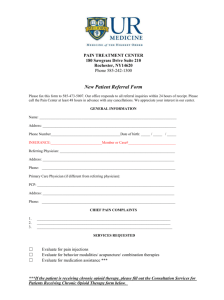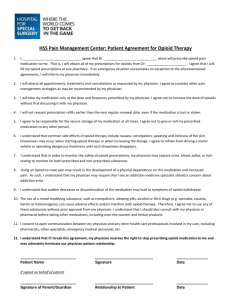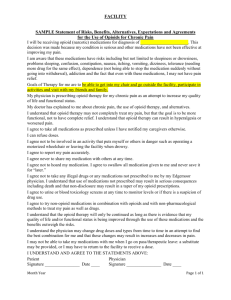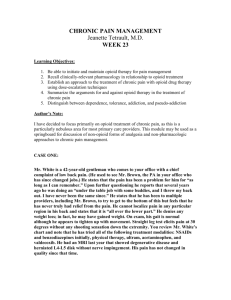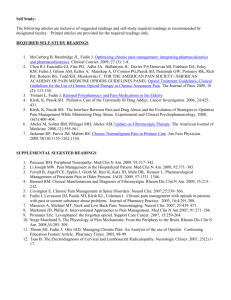Chronic Pain Management Policy
advertisement
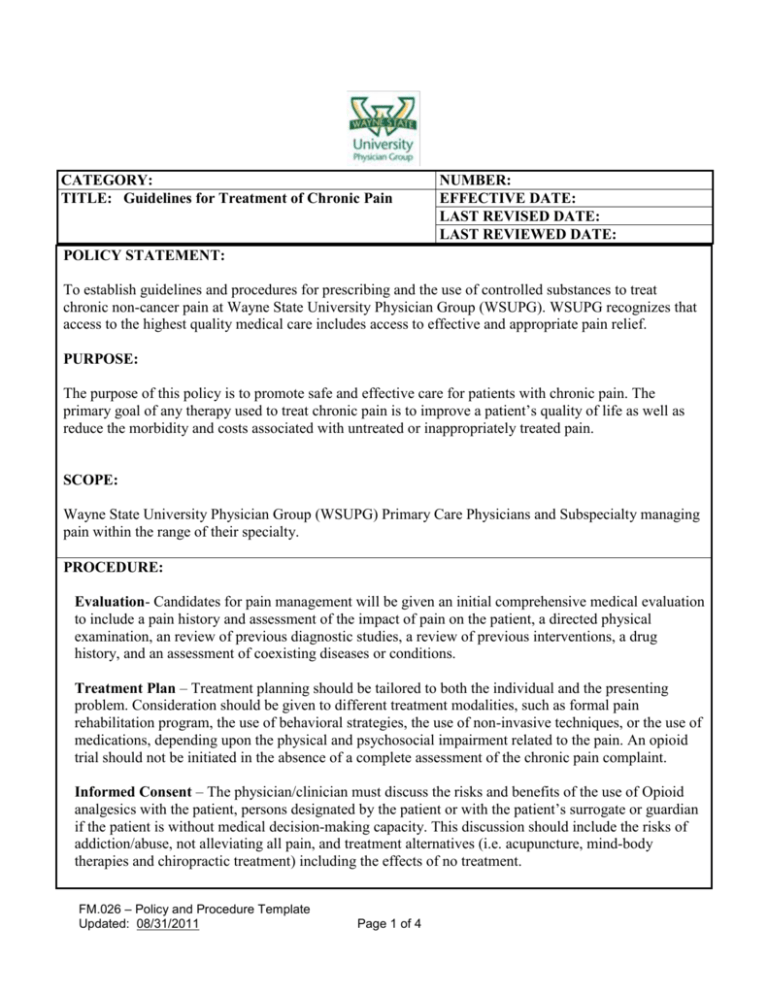
CATEGORY: TITLE: Guidelines for Treatment of Chronic Pain NUMBER: EFFECTIVE DATE: LAST REVISED DATE: LAST REVIEWED DATE: POLICY STATEMENT: To establish guidelines and procedures for prescribing and the use of controlled substances to treat chronic non-cancer pain at Wayne State University Physician Group (WSUPG). WSUPG recognizes that access to the highest quality medical care includes access to effective and appropriate pain relief. PURPOSE: The purpose of this policy is to promote safe and effective care for patients with chronic pain. The primary goal of any therapy used to treat chronic pain is to improve a patient’s quality of life as well as reduce the morbidity and costs associated with untreated or inappropriately treated pain. SCOPE: Wayne State University Physician Group (WSUPG) Primary Care Physicians and Subspecialty managing pain within the range of their specialty. PROCEDURE: Evaluation- Candidates for pain management will be given an initial comprehensive medical evaluation to include a pain history and assessment of the impact of pain on the patient, a directed physical examination, an review of previous diagnostic studies, a review of previous interventions, a drug history, and an assessment of coexisting diseases or conditions. Treatment Plan – Treatment planning should be tailored to both the individual and the presenting problem. Consideration should be given to different treatment modalities, such as formal pain rehabilitation program, the use of behavioral strategies, the use of non-invasive techniques, or the use of medications, depending upon the physical and psychosocial impairment related to the pain. An opioid trial should not be initiated in the absence of a complete assessment of the chronic pain complaint. Informed Consent – The physician/clinician must discuss the risks and benefits of the use of Opioid analgesics with the patient, persons designated by the patient or with the patient’s surrogate or guardian if the patient is without medical decision-making capacity. This discussion should include the risks of addiction/abuse, not alleviating all pain, and treatment alternatives (i.e. acupuncture, mind-body therapies and chiropractic treatment) including the effects of no treatment. FM.026 – Policy and Procedure Template Updated: 08/31/2011 Page 1 of 4 Agreement for Treatment – Before initiating chronic opioid therapy, the patient will be required to complete a verbal or written agreement (see Appendix A) between physician and patient outlining patient and physician responsibilities for safe and responsible opioid prescribing. Such an agreement should include: a. b. c. d. Urine/serum medication levels and baseline screening when requested Number and frequency of all prescription refills Reasons for which drug therapy may be discontinued (e.g., violation of agreement) Requirement that the patient receive all controlled substance prescriptions from one physician and one pharmacy whenever possible. e. Prescriptions will not be obtained over the phone or on weekends Periodic Review – Review of treatment efficacy should occur periodically to assess any new information about the etiology of the pain or the patient’s state of health, the functional status of the patient, continued analgesia, opioid side effects, quality of life, and indications of medication misuse. Periodic re-examination is warranted to assess the nature of the pain complaint and to ensure that opioid therapy is still indicated. Attention should be given to the possibility of a decrease in global function or quality of life because of opioid use. Additionally: After initiating chronic opioid therapy, the patient will be required to follow-up based on their level of risk (i.e. low risk patients every 3-6 months, moderate and high risk will be seen more frequently). Risk Level Patient Characteristics Low Risk Moderate Risk No history of substance use problem, past or current No contributory family history of substance abuse No major or untreated mental health problems History of substance use problem (treated) Family history of substance abuse Comorbid minor or past major mental health problem Current substance use problem Active addiction Major untreated mental health problem High Risk FM.026 – Policy and Procedure Template Updated: 08/31/2011 Page 2 of 4 1. All patients on chronic opioid therapy should have periodic review of their narcotic prescription filling pattern. This will be reviewed through MAPS (Michigan Automated Prescription System). a. It is the responsibility of the physician to pull their own MAPS, if the physician does not have a MAPS sign-on they can register with the State of Michigan (Appendix B-1 and Appendix B-2). MAPS sign-on and password cannot be shared with any support staff (see policy HIP.ADM.009). b. Maps reports are to be destroyed after review and cannot be shared with the patient or scanned into patient’s chart. However, the clinician may document references from the MAPS review into the patient record. c. Use of controlled substances other than prescribed by the physician per the MAPS review may result in termination of opioid therapy. d. Substance abuse education must be given and documented in patient’s chart. e. All potentially fraudulent behavior identified during MAPS review should be handled with caution to ensure the safety of all others within the practice site during encounter. For example, notify police only after patient has left the location. 2. Patients will be subject to periodic urine drug testing based on risk stratification. 3. Abusive language, threats of physical violence, or physical violence will not be tolerated. Any patients exhibiting such behaviors during treatment will be discharged from WSUPG (see policy COR.005). Medical Records – The physician must keep accurate, legible and complete records that provide sufficient information for another practitioner to assume continuity of the patient’s care. These records should contain at a minimum the following: a. b. c. d. e. f. g. h. i. j. The medical history and physical examination Diagnostic, therapeutic and laboratory results that support the diagnosis Evaluations and consultations Treatment objectives Discussion of risks and benefits Documented verbal and/or written informed consent Treatments Medications (including date, type, dosage and quantity prescribed) Instructions and agreements, and Periodic reviews The physician must maintain current records in an easily accessible manner, and the records must be readily available for review. FM.026 – Policy and Procedure Template Updated: 08/31/2011 Page 3 of 4 Tapering/Weaning-Physicians should taper or wean patients off of pain management therapy who engage is aberrant drug-related behaviors or drug abuse, experience no progress towards meeting therapeutic goals, or experience intolerable adverse effects. Strategies for tapering: 1. A decrease by 10% of the original dose per week is usually well tolerated with minimal physiological adverse effects. Some patients can be tapered more rapidly without problems (over 6 to 8 weeks). 2. If opioid abstinence syndrome is encountered, it is rarely medically serious although symptoms may be unpleasant. 3. Symptoms of an abstinence syndrome, such as nausea, diarrhea, muscle pain and myoclonus can be managed with clonidine 0.1 – 0.2 mg orally every 6 hours or clonidine transdermal patch 0.1mg/24hrs (Cataprese TTS-1™) weekly during the taper while monitoring for often significant hypotension and anticholinergic side effects. In some patients it may be necessary to slow the taper timeline to monthly, rather than weekly dosage adjustments. 4. Symptoms of mild opioid withdrawal may persist for six months after opioids have been discontinued. 5. Consider using adjuvant agents, such as antidepressants to manage irritability, sleep disturbance or antiepileptics for neuropathic pain. 6. Do not treat withdrawal symptoms with opioids or benzodiazepines after discontinuing opioids. 7. Referral for counseling or other support during this period is recommended if there are significant behavioral issues. 8. Referral to a pain specialist or chemical dependency center should be made for complicated withdrawal symptoms. REFERENCE: Clinical Guideline for the Use of Chronic Opioid Therapy in Chronic Noncancer pain RELATED FORMS: Appendix A: Chronic Pain Management Agreement Appendix B-1: Registration for MAPS Application Appendix B-2: Online Instructions to Register for MAPS FM.026 – Policy and Procedure Template Updated: 08/31/2011 Page 4 of 4
